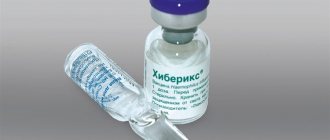Review
Acute otitis media is most often a bacterial or viral infection that affects the middle ear, the air-filled space behind the eardrum that contains tiny vibrating bones. Children are more likely than adults to suffer from this disease.
Acute otitis media is often painful due to inflammation and fluid buildup in the middle ear.
Since ear infections often clear up on their own, treatment may begin with pain management and monitoring the problem. Otitis media in infants, and in severe cases in general, often requires antibacterial drugs. Long-term inflammation—persistent fluid in the middle ear and frequent infections—can cause hearing problems and other serious complications.
What is otitis media?
The middle ear is the cavity between the eardrum (the inner border of the outer ear) and the inner ear. Inflammation of the middle ear is called otitis media. This disease often develops in children due to the structural features of the ear, especially the Eustachian tube, and in the presence of adenoiditis. Otitis media is usually caused by bacteria or viruses.
IMPORTANT! Information from the article cannot be used for self-diagnosis and self-medication! Only a doctor can prescribe the necessary examinations, establish a diagnosis and draw up a treatment plan during a consultation!
Symptoms
Symptoms of inflammation usually develop quickly.
Signs and symptoms common in children include:
- pain in the ears, especially when lying down;
- poor sleep;
- crying more than usual;
- difficulty listening or responding to sounds;
- loss of balance;
- fever (38 C or higher);
- discharge of fluid from the ear;
- headache;
- loss of appetite.
Common symptoms in adults include:
- earache;
- release of fluid;
- hearing loss.
When to go to the doctor?
With baby:
- if symptoms persist for more than one day;
- if the child has symptoms for less than 6 months;
- if your ear hurts a lot;
- if a child under 3 months of age with a common cold (ARVI) cannot sleep and is very worried;
- if fluid, pus, or blood leaks from the ear.
Symptoms of otitis media may indicate other serious diseases. Therefore, it is important that the doctor examine the baby. An adult with symptoms of otitis media should definitely see a doctor.
Causes
Inflammation in the middle ear is caused by bacteria or viruses. Often caused by a cold, flu, or allergies, it causes fluid to accumulate and swell in the nasal passages, throat, and auditory tubes.
The role of the auditory tube
The auditory tubes are a pair of narrow tubes that extend from the middle ear to the nasopharynx, behind the nasal passages. The laryngeal end of the tubes opens and closes to regulate air pressure in the middle ear and its drainage function.
Swelling, inflammation, and mucus in the eustachian tubes from an upper respiratory infection or allergies can block them, causing fluid to accumulate in the middle ear.
Ear infections are more common in children, in part because their eustachian tubes are narrower and more horizontal—factors that make it difficult for fluid to drain out of them, causing them to become clogged.
Role of adenoids
Adenoids are two small pads of tissue high at the back of the nose that play a role in the activity of the immune system. This feature makes them especially vulnerable to infection, inflammation and swelling.
Because the adenoids are located near the opening of the eustachian tubes, inflammation or enlargement of the adenoids can block the eustachian tubes, thereby facilitating middle ear infection. Inflammation of the adenoids will play a role in the development of otitis media in children because children have relatively large adenoids.
Other conditions that may be associated with an ear infection or the result of similar middle ear problems include the following:
- Otitis with effusion is inflammation and fluid formation (effusion) in the middle ear without bacterial or viral infection. This can happen because fluid accumulation persists after the ear infection has cleared. It may also occur due to some dysfunction or non-infectious blockage of the eustachian tubes.
- Chronic otitis media with effusion occurs when fluid remains in the middle ear and continues to return without bacterial or viral infection. This makes children susceptible to new ear infections and can affect their hearing.
- Chronic suppurative otitis is a persistent ear infection that often leads to rupture or perforation of the eardrum.
Risk factors
- Age. Children ages 6 months to 2 years are more susceptible to ear infections because of the size and shape of their eustachian tubes and because their immune systems are underdeveloped.
- Children's group. Children in group settings are more likely to get colds and ear infections than children who stay at home because they are exposed to more infections, such as colds.
- Baby food. Babies who drink from a bottle, especially while lying down, are more likely to develop ear infections than babies who are breastfed.
- Seasonal factors. Ear infections are most common during the fall and winter, when colds and flu are common. People with seasonal allergies are at greater risk of ear infections during seasonal allergies.
- Contaminated air. Exposure to tobacco smoke or high levels of air pollution can increase the risk of ear infection.
Complications
Frequent infections and constant build-up of fluid can lead to serious complications:
- Hearing impairment. An ear infection is often accompanied by mild hearing loss. Persistent infection or fluid in the middle ear can lead to more significant hearing loss. If there is some permanent damage to the eardrum or other structures of the middle ear, permanent hearing loss may occur.
- Delayed speech development. When hearing is temporarily or permanently impaired in infants and young children, they may experience delays in speech, social and mental development.
- Spread of infection. Infections that do not respond well to treatment may spread to nearby tissue. Infection of the mastoid process, the bony protuberance behind the ear, is called mastoiditis. This infection can cause bone damage and pus-filled cavities. Rarely, serious middle ear infections spread to other tissues in the skull, including the brain or meninges surrounding the brain (meningitis).
- Rupture of the eardrum. Most tears heal within 72 hours. In some cases, surgery is necessary.
Prevention
The following tips may reduce your risk of developing otitis media:
- Prevent colds and other illnesses. Teach your children to wash their hands frequently and thoroughly, and not to share food or drinks. Teach your children to cough or sneeze into their hand. If possible, limit the time your child spends in a group setting. Try to keep your child at home when he is sick.
- Avoid secondhand smoke. Try to stay in non-smoking areas.
- Breastfeeding your baby. If possible, breastfeed your baby for at least six months. Breast milk contains antibodies that may provide protection against ear infections.
- If you bottle feed, keep your baby upright. Avoid propping bottles in your baby's mouth while he is lying down. Do not put the bottle in the crib with your baby.
- Talk to your doctor about getting vaccinated. Ask your doctor about which vaccines are appropriate for your child. Seasonal flu shots, pneumococcal and other bacterial vaccines can help prevent ear infections.
What is the name of?
Today, vaccination against pneumonia, meningitis and otitis media, which are associated with pneumococcal infection, comes in two types:
- Polysaccharide vaccine. Allowed for use from 2 years of age.
- Conjugate vaccine. You can start administering it from two months of life.
For example, the pneumococcal 13-valent conjugate vaccine, which is used quite often, is called Prevenar 13. Other vaccinations may be called the same - pneumococcal polysaccharide 23-valent vaccine or 10-valent conjugate vaccine.
Today, vaccination is the most effective way to protect against various infectious diseases.
Diagnostics
Your doctor may diagnose an ear infection or other condition based on the symptoms you describe. To clarify the diagnosis and identify the cause of the disease, the doctor will use a special light-up instrument (otoscope) to look at the ears, throat and nasal passages.
Otoscopy
An otoscope is a specialized instrument that allows the doctor to examine the ear cavity and judge the presence of fluid behind the eardrum. Using an otoscope, the doctor can gently blow air against the eardrum. Typically, this air causes the eardrum to move. If the middle ear is filled with fluid, the doctor will hardly notice any movement of the eardrum.
Additional tests
Your doctor may perform other diagnostic tests if there is any doubt about the diagnosis.
- Tympanometry. This test measures the movement of the eardrum. The device that closes the ear canal regulates the air pressure in the canal, thereby causing the eardrum to move. The device quantifies how well the eardrum moves and a measure of the pressure inside the middle ear.
- Acoustic reflexometry. This test shows how the mobility of the eardrum changes in response to sound stimulation.
- Paracentesis. Sometimes the doctor may use a thin needle to pierce the eardrum to drain fluid from the middle ear, a procedure called paracentesis. If the infection does not respond well to previous treatment, then taking a smear of this fluid to determine the type of bacteria helps to choose the right antibiotic.
- Other tests. If your child has had persistent ear infections or persistent fluid build-up in the middle ear, your doctor may refer you to an audiologist, speech therapist, or therapist for testing of hearing, speech skills, language comprehension, or developmental abilities.
What does the diagnosis mean?
Acute otitis media. The doctor makes this diagnosis if he observes signs of fluid in the middle ear, if there are signs or symptoms of infection, and if the onset of symptoms was relatively unexpected.
Otitis with effusion. If the diagnosis is otitis media with effusion, the doctor has detected fluid in the middle ear, but there are currently no signs or symptoms of infection.
Chronic purulent otitis media. If the doctor makes this diagnosis, it means that he has discovered that a persistent ear infection is leading to a rupture or perforation of the eardrum.
Contraindications
Since the introduction of the pneumococcal vaccine into clinical practice, a significant reduction in morbidity and mortality has been observed. However, not all people can undergo specific prophylaxis. We list the main contraindications to vaccination:
- Previous vaccinations were accompanied by pronounced and severe systemic side effects such as anaphylactic reactions.
- The presence of hypersensitivity (allergy) to any component included in the vaccine.
- Acute infectious pathology or exacerbation of a chronic disease.
The vaccine is allowed to be given 10-12 days after the person has recovered or achieved remission. I would like to note that even if you have had pneumococcal infection before, you can still get vaccinated. Previous diseases are not a contraindication.
Treatment
Some ear infections resolve without antibiotic treatment. What's best for your child depends on many factors, including the child's age and the severity of symptoms.
Waiting tactics
Ear infections usually improve within the first two days, and most infections clear up on their own within one to two weeks without any treatment. The American Academy of Pediatrics and the American Academy of Family Physicians recommend waiting and seeing the outcome in the following cases:
- Children 6 to 23 months of age with mild internal pain in one ear for less than 48 hours and a temperature of less than 39°C.
- Children aged 24 months and older with mild internal ear pain on one or both sides for less than 48 hours and a temperature less than 39°C.
Some evidence suggests that antibiotic treatment may be effective for children with ear infections. Talk to your doctor about the benefits of antibiotics, their side effects, and the emergence of bacteria that are resistant to antibiotics when you overuse them.
Pain management
To reduce pain from an ear infection, your doctor may recommend using paracetamol (Calpol, Panadol, and others) or ibuprofen (Nurofen, Ibuclin, and others) to relieve the pain. Use medications as directed on the label. Use caution if giving aspirin to children or teenagers. Children and teenagers recovering from chickenpox or flu-like symptoms should never take aspirin because aspirin is associated with Reye's syndrome.
Antibiotic therapy
Your doctor may recommend treating otitis media with antibiotics in the following situations:
- Children 6 months of age and older with moderate/severe ear pain for more than 48 hours or a temperature of 39°C or higher.
- Children 6 to 23 months of age with mild internal ear pain lasting less than 48 hours and a temperature less than 39°C.
- Children aged 24 months and older with mild internal ear pain lasting less than 48 hours and a temperature less than 39°C.
In children under 6 months of age with confirmed acute otitis media, treatment should be started with antibiotics without an initial wait and observation period. Even after symptoms have improved, be sure to complete the course of antibiotics as recommended. Failure to follow this recommendation may result in recurrent infections and bacterial resistance to antibiotic therapy. Talk to your doctor about what to do if you accidentally miss an antibiotic dose.
Bypass surgery
If your child has recurrent otitis media or otitis media with effusion, the doctor may recommend a procedure to remove fluid from the middle ear. Recurrent otitis media can be said to occur if there have been three episodes of infection in six months or four episodes in a year, or at least one episode in the last six months. Recurrent otitis with effusion is a constant build-up of fluid in the ear after recovery or in the absence of any infection.
During an outpatient surgical procedure called a shunt, the surgeon creates a tiny hole in the eardrum that drains fluid from the middle ear. A tiny tube (shunt) is placed in the hole to help ventilate the middle ear and continue to drain fluid for the required amount of time. The shunt is installed for 3-6 months and removed surgically. The eardrum usually closes again after the shunt is removed.
Treatment of chronic suppurative otitis media
Chronic suppurative otitis media leads to perforation of the eardrum and is difficult to treat. It is often treated with antibiotics given as drops.
Vaccine safety
After administration of pneumococcal conjugate vaccine, various post-vaccination reactions may develop. In approximately every fifth case, the following side effects are observed after vaccination:
- The temperature rises to 39 °C.
- Appetite decreases.
- Problems with sleep appear.
- Swelling, redness (hyperemia), pain and hardening occur in the injection area.
Most of the above reactions develop in the first two days after administration of the pneumococcal vaccine and go away on their own without the use of specific treatment. In some situations, you should use antipyretic and antihistamine medications (for example, Paracetamol, Ibuprofen, Suprastin, Tavegil, etc.).
In rare cases, after vaccination, the appearance of diarrhea, vomiting, rashes, urticaria, seizures, shortness of breath, breathing problems, general agitation, etc. has been observed. It has been clinically established that local post-vaccination reactions in older children are more pronounced compared to infants.
Even if you are vaccinated against pneumococcal infection, you may develop pneumonia, meningitis or otitis media, but the causative agent of these inflammatory diseases will be a completely different pathogenic microorganism.







